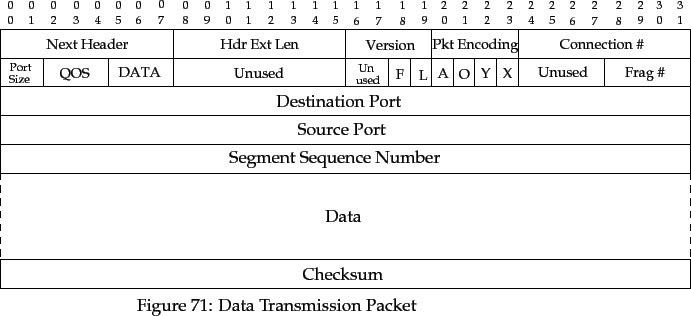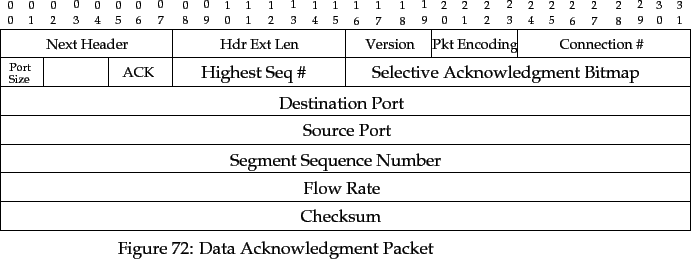



Next: D. Complexity of RBCC
Up: Warrens Ph.D Thesis
Previous: B. Verifying TRUMP with
Contents
Subsections
C. TRUMP Protocol Headers
TRUMP is a transport protocol which provides for the reliable delivery of data
across an unreliable packet-switched network. Chapter 5
gives a feature-oriented examination of the TRUMP transport protocol.
This appendix describes a proposed set of TRUMP headers for use in an
IPv6 network.
In the following section, all fields are unsigned integers or, if single bits,
boolean flags. All multi-octet fields in TRUMP's headers are stored in
big-endian format. All diagrams are 4 octets wide. For fields where not all
the possible values are enumerated, the undefined values are currently invalid
and reserved for future use. Fields that are described as `unused' should be
set to all bits off.
The first 64 bits of each TRUMP header are nearly identical for all packet
types, and are shown in the following figure. A description of each field
follows.

- Next Hdr
- Part of the IPv6 header specification, described
in [Stallings 96].
- Hdr Extension Length
- Part of the IPv6 header specification, described
in [Stallings 96].
- Version
- The version of the transport protocol. The current
TRUMP version is 2. Future versions of TRUMP will have higher
version numbers.
- Packet Encoding
- The encoding of the packet from the Connection
Number field onwards. This is predominately used to allow for
encryption of transport protocol packets. Currently, only two values
out of the sixteen possible are defined:
- 0
- The header and data are in plain-text.
- 1
- The header (with the exception of the first four fields)
and data are encrypted in DES block mode, using
a key negotiated by the source and destination
endpoints. The method of key negotiation is not a
part of the TRUMP protocol. The checksum is not encrypted,
and is set to the checksum of the whole packet after
encryption.
- Connection Number
- Currently, this field is not used and reserved.
In future versions of TRUMP, it will hold a number that uniquely
identifies the (source, destination, source port, destination port)
tuple.
- Port Size
- Identifies the size of the endpoint identifiers.
The four possible values are:
- 0
- Endpoint identifiers are 0 bits in size.
- 1
- Endpoint identifiers are 16 bits in size.
- 2
- Endpoint identifiers are 32 bits in size.
- 3
- Endpoint identifiers are 64 bits in size.
The latter two are designed for use in distributed systems, where
large integers can be used to store such things as
object descriptors and capabilities.
- Quality of Service
- Used in SETUP packets and in DATA packets
where the Y bit is set. The field is invalid at any other time,
and must be set to all bits off. The field holds the requested quality
of service for the connection. Two values are currently defined:
- 0
- Reliable. The destination sends ACKs and the source
retransmits.
- 1
- Time-sensitive. The destination sends ACKs but the source does
not retransmit lost data.
- Packet Type
- The type of packet. Five values are currently defined:
- 0
- A SETUP packet.
- 1
- A DATA packet.
- 2
- An ACK packet.
- 3
- A SACK packet.
- 4
- A TEARDOWN packet.
- Error
- Indication of any error that has occurred. This field is
only valid for a SACK packet, and must be set to all bits off
in any other packet. Defined values are given below.
Bits 50 to 55 are used to hold bit fields for particular packet types.
The fields shown are described below. Refer to the rest of this section
for details of the other fields in each packet type.
- A - Return ACK Immediately
- Used in DATA packets. If set,
the destination must return an ACK packet for this DATA packet
immediately. This field is illegal in other packets.
- O - Last segment
- Used in DATA packets. If set, the segment
in the DATA packet is the last in the message.
This field is illegal in other packets.
- Y - DATA is Implicit SETUP
- Used in DATA packets. If set, the
DATA packet holds the first segment of the message, and is an
implicit SETUP. The QOS field is not valid in a DATA packet if this is
not set. This field is illegal in other packets.
- X - Explicit Teardown
- Used in SETUP and SACK packets.
If set, the source must perform an explicit connection teardown.
This field is illegal in other packets.
In addition, there are fields in each DATA packet that are
used if a source must fragment a segment.
- F - Segment is a Fragment
- If set, the segment is a fragment of another
segment. The segment sequence number is the same as the original
segment. This field is illegal in non-DATA packets.
- L - Last Fragment
- If set, the segment is the last fragment of another
segment. This field is illegal in non-DATA packets.
- Fragment Number
- The fragment number of the given fragment. If
F is not set, this field is invalid. This field is illegal in
non-DATA packets.
Explicit connection setup in TRUMP is performed by transmission of
a SETUP packet from source to destination, acknowledged by a
SACK from destination to source. This exchange passes the
message identification, source and destination port, and type of
connection teardown to the destination, and returns flow control
information or a connection failure error to the source.
The SETUP packet has the fields as shown in the following figure.

- Destination Port
- The TRUMP destination port of the connection.
- Source Port
- The TRUMP source port of the connection.
- Initial Segment Sequence Number
- The first segment in the message will
have this sequence number.
- Checksum
- A 32-bit checksum calculated over the fields in
the packet. This is calculated using the algorithm
described in [Fletcher 82].
In all TRUMP packets, the Source Port and Destination Ports
are variable-sized, from zero- to 64-bits. The figures shown above and
following give packets where these fields are 32-bits in size.
Explicit connection setup in TRUMP is acknowledged by a SACK packet.
This packet is also used to abnormally terminate a message transmission
(i.e an established connection).
The SACK packet has the fields as shown in the following figure.

The SACK packet has the following extra fields:
- Error
- Indication of any error that has occurred. Defined values are:
- 00
- No error has occurred.
- 01
- The destination port doesn't exist.
- 02
- The destination port is currently unavailable.
- 03
- The source port doesn't have enough privileges for the
connection.
- 04
- The source machine doesn't have enough privileges for the
connection.
- 05
- The destination port has been destroyed.
- 06
- The destination cannot continue the connection.
- 07
- The destination TRUMP implementation cannot cope
with the requested port size.
- 08
- The destination TRUMP implementation cannot cope
with the requested encryption scheme.
- 09
- The destination TRUMP implementation cannot cope
with the requested quality of service.
- 10
- The last packet from the source had a port size
different than that specified in the initial SETUP
packet.
- Destination Port
- The TRUMP destination port of the connection.
- Source Port
- The TRUMP source port of the connection.
- Checksum
- A 32-bit checksum calculated over the fields in
the packet. This is calculated using the algorithm
described in [Fletcher 82].
The DATA packet is used to transport data from the source to the
destination.

The DATA packet has the following extra fields:
- Destination Port
- The TRUMP destination port of the connection.
- Source Port
- The TRUMP source port of the connection.
- Segment Sequence Number
- The sequence number of the segment in
the DATA field.
- Data
- The actual payload of the packet, a TRUMP message segment.
- Checksum
- A 32-bit checksum calculated over the fields in
the packet. This is calculated using the algorithm
described in [Fletcher 82].
The ACK packet is used to acknowledge data from the source.

The ACK packet has the following extra fields:
- Destination Port
- The TRUMP destination port of the connection.
- Source Port
- The TRUMP source port of the connection.
- Segment Sequence Number
- The sequence number of the first segment
being acknowledged by this packet.
- ACK Bitmap
- The bitmap that selectively acknowledges up to 16
segments. Assume the Segment Sequence Number is
 . If segment
. If segment
 was received correctly, bit
was received correctly, bit  is set on; otherwise, it
is set to zero.
is set on; otherwise, it
is set to zero.
- Highest Sequence Number
- The highest sequence number
 positively or
negatively received in the bitmap, relative to the Segment Sequence
Number
positively or
negatively received in the bitmap, relative to the Segment Sequence
Number  . Sequence numbers
. Sequence numbers  are not acknowledged in the
bitmap.
are not acknowledged in the
bitmap.
- Flow Rate
- The highest bit rate of segment transmission by the
source which will not cause buffer overflows in the destination.
- Checksum
- A 32-bit checksum calculated over the fields in
the packet. This is calculated using the algorithm
described in [Fletcher 82].
The TEARDOWN packet is used to explicitly close a finished message
(i.e a completed connection).
This allows the destination to remove data
structures that it might have kept in order to detect delayed, out of
sequence, or duplicate packets.

The TEARDOWN header has the following fields:
- Destination Port
- The TRUMP destination port of the connection.
- Source Port
- The TRUMP source port of the connection.
- Checksum
- A 32-bit checksum calculated over the fields in
the packet. This is calculated using the algorithm
described in [Fletcher 82].




Next: D. Complexity of RBCC
Up: Warrens Ph.D Thesis
Previous: B. Verifying TRUMP with
Contents
Warren Toomey
2011-12-04






